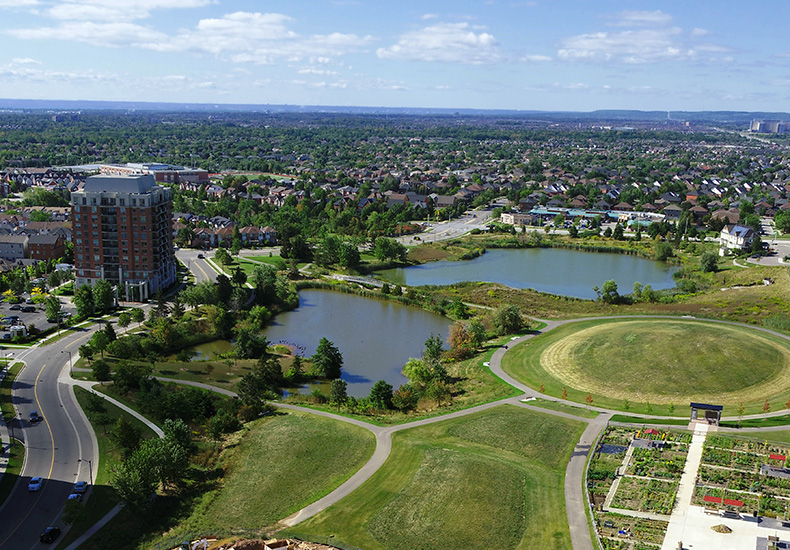Stormwater Management Ponds
Ponds that help control the flow of surface water from a rain storm or melting snow.

In developed areas, there are a lot of hard surfaces, such as pavement and buildings. Runoff water from rainfall and melted snow can not easily absorb into the ground through these hard surfaces.
Runoff build up and travels quickly to the storm sewers, creeks and Lake Ontario. As the runoff water accumulates, the risk of creek erosion and flooding increases. Runoff water can also pick up contaminants from the hard surfaces.
Stormwater management ponds (SWMPs) help to control the quantity and quality of water runoff that enters storm sewers, creeks and Lake Ontario. SWMPs help prevent flooding, creek erosion and pollution.
The town currently operates and maintains 52 SWMPs and there are 15 additional ponds awaiting assumption by the town.
Our stormwater management system directs water into SWMPs using catch basins, storm sewers and overland flow routes.
All SWMPs have at least one inlet that receives runoff water from the stormwater network. The runoff water is stored in the SWMPs and released at a slower and controlled rate. This reduces the potential for creek erosion and flooding.
SWMPs also improve water quality. Debris and contaminants in the runoff water settle to the bottom of the SWMPs as sediment before the runoff water is released. The areas around the SWMPs are also landscaped with dense natural vegetation to help filter sediment.
Visit our YouTube channel to learn more about how these ponds work.
We complete visual inspections of all SWMPs each year. These inspections identify routine and non-routine maintenance requirements.
Routine maintenance includes:
Non-routine maintenance includes:
SWMPs will not function properly if they are full of sediment. When the sediment reaches a certain level, the SWMPs must be drained and the sediment removed.
Depending on their size and location, SWMPs normally require sediment removal approximately every 10 to 25 years.
A few things that you can do to help our SWMPs and improve water quality include:
Benefit of a litter clean up!
For your health and safety recreational activities are prohibited, including, but not limited to:
Due to water constantly moving in and out of the SWMPs, water levels can change quickly. In addition, ice that forms in the winter is unpredictable because there may be salt in the water.
Safety/warning signs have been placed at each of the ponds to inform you of prohibited activities. If you visit our SWMPs with younger family members or friends, please review the warnings and make sure everybody understands.
For more on stormwater management pond safety, here is a message from our Fire Chief.
ServiceOakville
905-845-6601